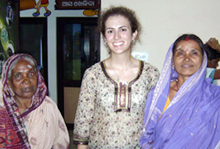 As the daughter of a diplomat, my life has been characterized by an endless cascade of people, places, opportunities, experiences, and contrasts. The theme of my past two summers has been global health, but my current internship working in monitoring and evaluation at CapacityPlus is almost the antithesis of my volunteer work in a rural eye hospital in India last year.
As the daughter of a diplomat, my life has been characterized by an endless cascade of people, places, opportunities, experiences, and contrasts. The theme of my past two summers has been global health, but my current internship working in monitoring and evaluation at CapacityPlus is almost the antithesis of my volunteer work in a rural eye hospital in India last year.
Two very different summers
Although I shiver in the hyperactively air-conditioned Washington DC office, I enjoy my own cubicle complete with a laptop and phone and big swirling chair, and I appreciate immensely the opportunity to interact with colleagues who’ve led incredible lives. I take lots of notes, work on compiling an indicator compendium to measure the state of human resources for health, and am starting to learn how global health is affected on a policy level. Read more »
